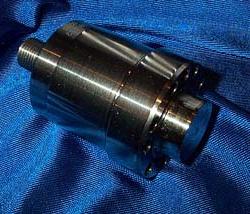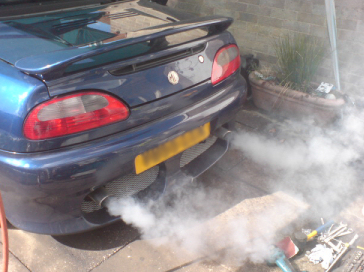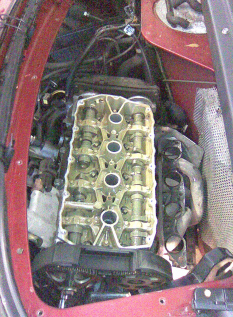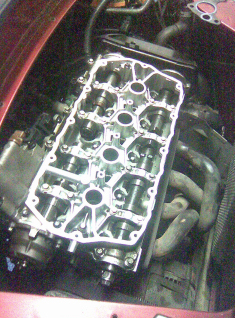|
The K series was originally made
with a maximum displacement of 1400cc, but over time
this was raised to 1600cc and 1800 cc. These larger
sized engines however result in larger stresses and
heat. The K series has a sandwich construction, with
very long through bolts going from the top to the
bottom of the engine and clamping it together using
these bolts. The engine construction is mainly alloy
with iron liners. The liners and engine have a
different expansion rates and so the design of the
head gasket takes this into account, this is why the
head gasket is actually a very clever design.
The gasket is sealed using a bead of sealant. This
sealant has a breakdown point of 250 degrees c.
However around the front of the engine near the
exhaust manifold temperatures around 200 degrees c
can be recorded, This is dangerously close to the
breakdown point of 250.
There are two common points of failure of the
standard K series gasket and both involve
displacement of the sealing bead leading to coolant
loss, one externally and the other internally.
· External loss is seen either with coolant dripping
under the car or with plenty of steam from
evaporation on the exhaust.
· Internal loss is mostly hidden and can lead to a
severe overheating problem before it is noticed.
This type of failure can result in major engine
damage including Cracked pistons, piston rings, and
even cracked cylinder heads.
The next main influence comes from head to block
movement, known as ‘head shuffle’. Originally the
head gasket was held with nylon dowels. In 2001
these were changed to steel dowels making the whole
engine a lot more rigid.
The next change happened in 2003 for the 2004 model
this involved the movement of the thermostat from
the original position at the inlet back into the
engine. This change allowed much closer monitoring
of the engine coolant. This valve is know as a
pressure release valve or PRV.
Land Rover part numbers are LVB500190 (head gasket)
and LCN000140L (lower rail)
Freelander (1997-2000) Engine code K18 118bhp @
5550rpm
Freelander (2000-2006) Engine code 18K16 117bhp @
5500rpm
The Phase Variator

The Achilles heel of the 16V twin
spark engines has always been the phase variator on
the inlet camshaft. According to an Alfa Romeo
service bulletin, there have been several editions,
the earlier of which were particularly prone to
premature failure
Variable valve timing gave the Twin Spark engine
very good performance for its cubic capacity it is
one of the weaker areas of the 16 valve engine. The
variator solenoid that controls the cam timing is
prone to wear or jam.
The Function of the VVT unit or phase variator is to
1. Reduce emissions
2. Produce a better torque output under various
operating conditions.
The solenoid valve controls the oil supply to the
variator depending on the load conditions of the
engine which is calculated by the ecu using the RPM
sensor & air flow meter.
It does this by altering the inlet camshaft position
(or phase) by 25 degrees relative to the crank
position, it does not and cannot alter valve lift or
duration, that is decided by the camshaft profile
which can't possibly change as its a solid cast
Your Car should not be smoking
like this! This is a sign of the head gasket going
or gone.

Advance stage
The sliding valve is pushed down as the ecu operates
the relay which supplies current to the solenoid.
Oil is now pumped through supply line A to B, D and
also L. The variator is now getting a pressurised
oil supply, which causes the ram to overcome the
force of its return spring and be pushed away from
the camshaft pulley.
it is the straight cut splines on the centre of the
variator (or the part which screws onto the cam) and
the helical cut teeth on the inner surface of the
shell of the variator which causes the variation in
relationship of the inlet cam pulley and the shaft
itself.
Retard stage
The sliding valve (2) has now lifted because the
solenoid has no current flow, this allows the slide
valve to lift because of the force provided by its
return spring (3) thereby opening port E
Pressure is reduced in lines D and L.
The strong spring in the variator is pushing the ram
back home, this causes the inlet cam to revert back
to its retard position because the oil flows back
through the camshaft, D also L, A and B to the slide
valve where it goes to E, the lubrication system
return line.
The D&L lines both go to the same oil feed bearing
journal, the L line looks like it can be done
without, but that would cause the journal to only
receive lubrication when the variator is advanced,
which is a bad thingWhen we
remove the engine covers your engine looks horrible!


But once we have cleaned and polished and pressure
tested it goes back sparkling new!
Or service is second to none, you wont be
disappointed |